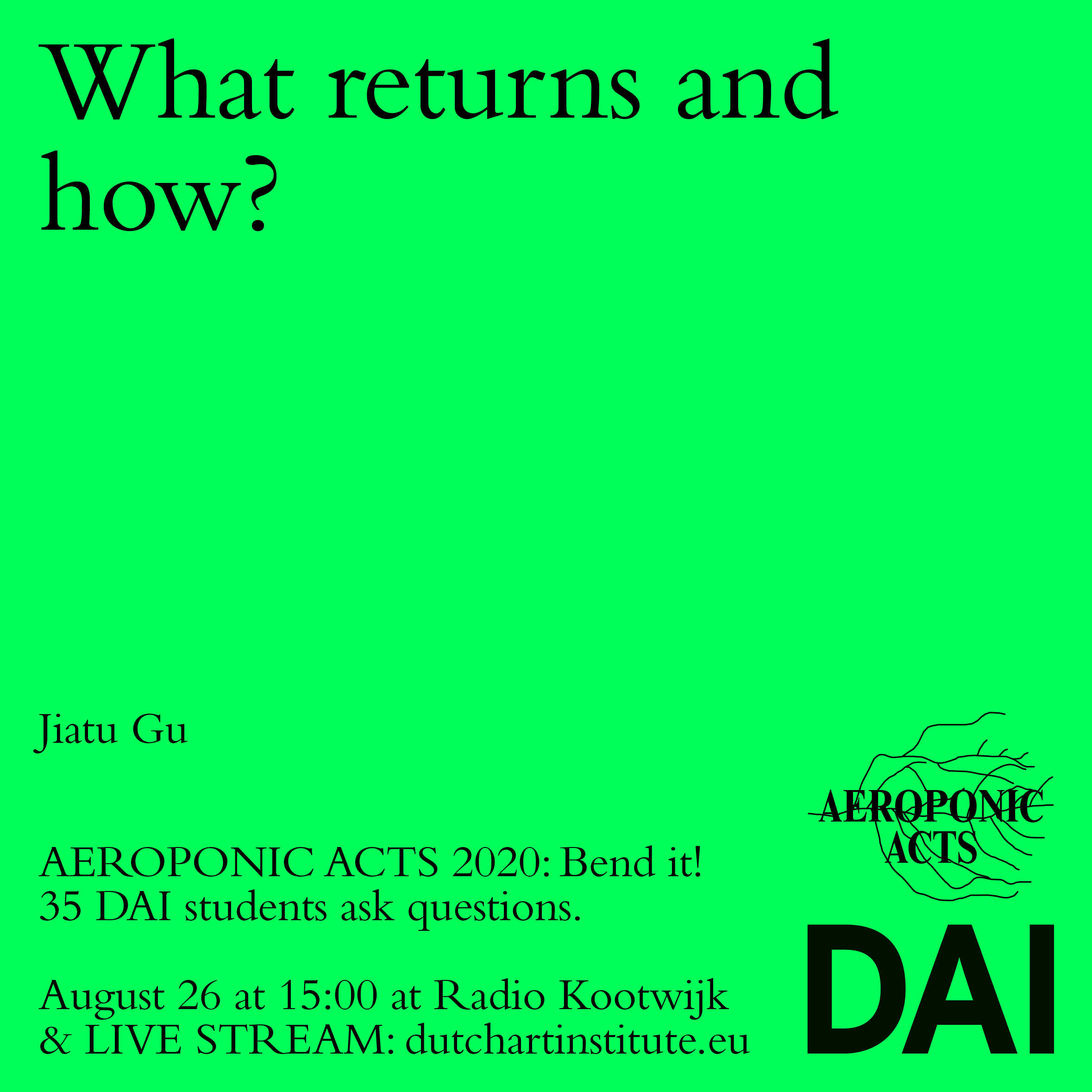Jiatu Gu: Nine Suns – the ones to come
‘Aeroponic’ – root systems nourished by air – Acts is the name given to the nomadic Dutch Art Institute’s final Kitchen presentations. Each participant addresses one question.
Here you will find the documentation of Jiatu Gu's presentation as filmed by Baha Görkem Yalım. The written report is by Bethany Crawford and it includes a summary of the comments by esteemed guest respondents.
Nine Suns—the ones to come
Jiatu's question: What returns and how?
Jiatu's introduction: According to Chinese mythology, there were ten suns in the sky, when Yao was the leader of the confederation of tribes. The crops were scorched, and the grass and trees were destroyed. The common people were starved to death. At the same time, the monsters and demons ran wild and did great harm to the people. Yao sent Hou Yi to kill them. Hou Yi killed the sharp teeth monster in the wilderness, slew the cruel dragon in the turbulent river, captured the storm demon in the valley of Qingqiu Mountains, cut the longest snake in Dong Ting Lake and captured the largest beast in the mulberry forest. After destroying all the monsters, he shot down the nine blazing suns keeping only one in the sky. Then, the mass could live a stable life again. Yi became the hero eulogized by the later generations. This work takes the nine suns as the metaphor, intersecting with the reality of capitalistic anthropocene, attempting to bash this imperial narrative of subjectivity and identity.
Bethany's report: The artist writes: ‘According to Chinese mythology, there were ten suns in the sky, when Yao was the leader of the confederation of tribes. The crops were scorched, and the grass and trees were destroyed. The common people were starved to death. At the same time, the monsters and demons ran wild and did great harm to the people. Yao sent Hou Yi to kill them. Hou Yi killed the sharp teeth monster in the wilderness, slew the cruel dragon in the turbulent river, captured the storm demon in the valley of Qingqiu Mountains, cut the longest snake in Dong Ting Lake and captured the largest beast in the mulberry forest. After destroying all the monsters, he shot down the nine blazing suns keeping only one in the sky. Then, the mass could live a stable life again. Yi became the hero eulogized by the later generations.’ A length of black fabric hangs from the edge of the balcony down to the floor, with a golden circle painted on it. The crouching silhouette of the performer within the material is made visible through the cinching of the fabric around their neck. The audience stands in a semi-circle, as a multimedia collage with a sped-up medley of Chinese imagery from rural countryside to cityscape becomes more layered, textured and affected. It is complemented by an equally surreal and fluctuating soundtrack with classical music, weather sounds and artificial renderings of nature. The uncanny work evokes a science-fiction realm tethered to current reality. As the image track ends and the soundscape moves into a pulsating beat, the performer moves forward, still encased in the fabric. The material becomes a shroud, the length trailing behind the performer who blindly walks himself around the space by holding the end of the dog lead around his neck.
This dense work required a lot of unravelling, said Amal Alhaag, interested in processing the myth of the ten suns, and thinking about the hidden metaphor within that in relation to how the artist brings forward the Anthropocene in the abstract. She related the presentation to decolonial French feminist Françoise Vergès’ text ‘Racial Capitalocene’, which expands on the critique of the Anthropocene, starting with: ‘How can we have the conversation when so many of us are not human yet?’ and questions how his translates in a country that carries the burden of the disposable workers and waste as part of the capitalist machine. Alhaag commented on moving from the hinterlands into the city where the weather has changed. She returned to the myth of one sun left and the question of what returns, which she said could potentially be the return of human waste. She registered the cultural translation of the red hand, and the violence attached to the colour in that context, but found it difficult to process the ending due to its proximity to the symbolism of lynching or violence of hanging.
While interesting, Flavia Dzodan found it difficult to connect the piece as a whole work emotionally, but saw in it an element of feminist critique of the Anthropocene and was very impressed with the sound, which she thought did bring the work together. She expected more fantastical visuals that instead had turned out to be gritty and real. Instead of doing away with homogenous masculinity, aspects were actually reinforced she said, associating it with a certain type of violence: a roaming figure with a patriarchal, imperial presence, which she wasn’t sure the artist wished to deconstruct or leave standing.
For Ana Teixeira Pinto the piece was very compelling, and the story fascinating as a narrative about empire building and centralization. She guessed it coincided with the monetization of the Chinese empire and the extraction of resources from the land, a narrative often left out in the first wave of globalization. It recalled how silver and gold extracted from South America was put into empire building in other parts of the world, and energy-driven as opposed to resource economies. She stumbled on the question, ‘What returns and how?’, but read it in reference to the furnaces of the industrialization – when powers all over the world exploded leading us to the present situation.
Jiatu Gu's Nine Suns—the ones to comewas presented at Radio Kootwijk.
Find the overview of all 35 AEROPONIC ACTS 2020 here: BEND IT!

